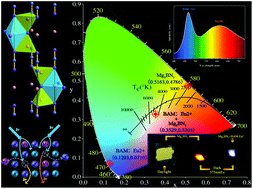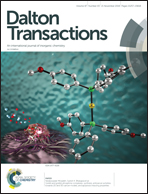Design and research of a self-activated orange magnesium boron nitride phosphor with its application in W-LEDs†
Abstract
In recent years, the rare-earth elements in white light-emitting phosphors have a problem of increased demand and high price. To overcome these disadvantages, defects have been considered to act as new efficient luminescent centers to replace rare-earth elements. In this work, a rare-earth free self-activated orange light emitting phosphor of single-phase magnesium boron nitride, Mg3BN3, was successfully designed and synthesized by a relatively simple solid-state reaction. Its crystal structure and electronic structure have been measured using Rietveld refinement on the basis of X-ray diffraction data and density functional theory (DFT). The results show that Mg3BN3 crystallizes in a centrosymmetric hexagonal phase with plenty of N![[double bond, length as m-dash]](https://www.rsc.org/images/entities/char_e001.gif) B
B![[double bond, length as m-dash]](https://www.rsc.org/images/entities/char_e001.gif) N double bonds and has a direct bandgap. The SEM and TEM images and Raman spectra exhibit the sample's good dispersibility and great crystallinity. Under excitation at 397 nm, a broad emission band with orange light emission peaked at 617 nm can be obtained. It is speculated to result from the defect energy levels formed by vacancies, which can also lead to tunability of the emission peak at about 100 nm. The thermal quenching shows that Mg3BN3 at 200 °C still has more than 40% of the initial intensity at room temperature. All these results indicate that the self-activated light emitting phosphors of Mg3BN3 are a potential candidate for n-UV LED applications.
N double bonds and has a direct bandgap. The SEM and TEM images and Raman spectra exhibit the sample's good dispersibility and great crystallinity. Under excitation at 397 nm, a broad emission band with orange light emission peaked at 617 nm can be obtained. It is speculated to result from the defect energy levels formed by vacancies, which can also lead to tunability of the emission peak at about 100 nm. The thermal quenching shows that Mg3BN3 at 200 °C still has more than 40% of the initial intensity at room temperature. All these results indicate that the self-activated light emitting phosphors of Mg3BN3 are a potential candidate for n-UV LED applications.



 Please wait while we load your content...
Please wait while we load your content...